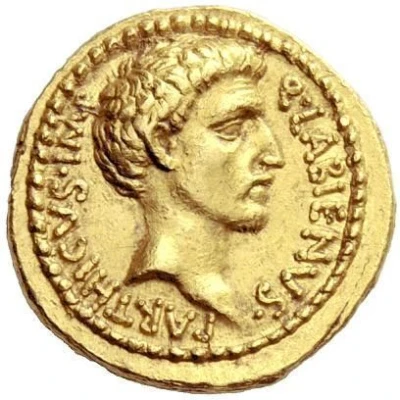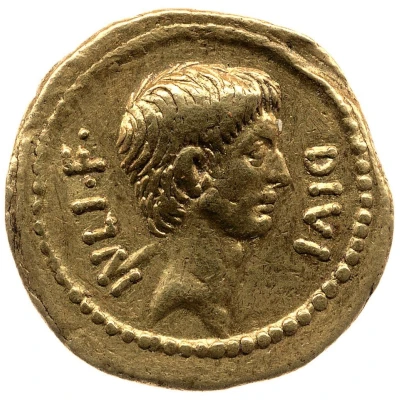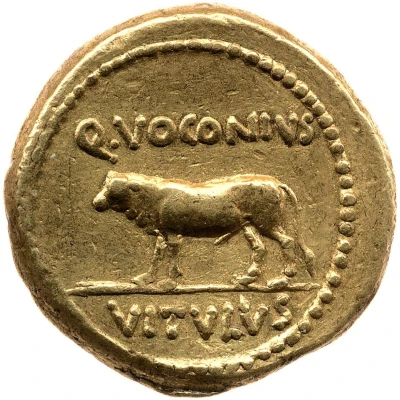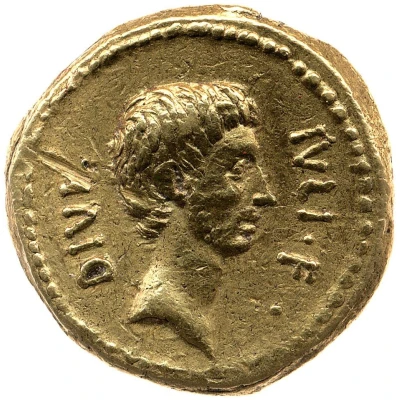
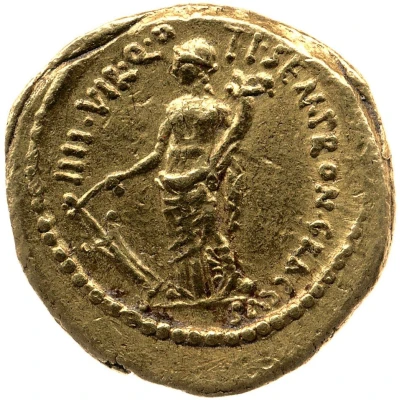

Aureus - Octavian DIVI IVLI·F / TI·SEMPRON·GRACCVS IIII·VIR·Q·D 40 BC
40 BC year| Gold | 8.06 g | 20 mm |
| Issuer | Rome › Roman Republic (509 BC - 27 BC) |
|---|---|
| Period | Republic (509 BC - 27 BC) |
| Triumvir | Octavian (Caius Octavius) (43 BC - 32 BC) |
| Type | Standard circulation coin |
| Year | 40 BC |
| Value | Aureus (25) |
| Currency | Denarius of 16 Asses (141 – 27 BC) |
| Composition | Gold |
| Weight | 8.06 g |
| Diameter | 20 mm |
| Shape | Round (irregular) |
| Technique | Hammered |
| Orientation | Variable alignment ↺ |
| Demonetized | Yes |
| Updated | 2024-10-06 |
| Numista | N#333602 |
|---|---|
| Rarity index | 100% |
Reverse
Fortuna standing left, holding rudder in right hand and cornucopiae in left hand.
Border of dots.
Script: Latin
Lettering: TI·SEMPRON·GRACCVS IIII·VIR·Q·D
Unabridged legend: Tiberius Sempronius Quatuorvir Quaestor Designatus
Translation: Tiberius Sempronius Gracchus, quatuorvir, questor designated
Comment
Only eight specimens known.
Babelon Julia 127 and Sempronia 12; Bahrfeldt 102; C 522; RBW –. Biaggi 77.
In 40 B.C. the Roman numismatic landscape was diverse and complex. Two moneyers issued coins at Rome, including this aureus with the portrait of Octavian. Additionally, Octavian issued his own coins at mints outside of the capital, as did four others: Sextus Pompey in Sicily, Marc Antony and Quintus Labienus in the East, and Domitius Ahenobarbus in the region of the Adriatic or Ionian Sea. After the Battle of Philippi in October 42 B.C., Octavian began the thankless task of settling some 40,000 veterans on their promised lands. As he acquired land in Italy by force, his popularity suffered, and Marc Antony's wife Fulvia and brother Lucius Antonius preyed upon his misfortune. Their political attacks stirred the veterans of Antony against those of Octavian, culminating in the Perusine War (41-40 B.C.). Octavian triumphed in this conflict and afterwards, upon the death of Antony's governor, seized Gaul for himself. Alarmed by these events, Antony sailed west to settle matters with Octavian. Though their meeting was preceded with hostilities and a siege of Brundisium by Antony, the triumvirs were able to settle their differences. The resulting pact of October 40 B.C. confirmed Antony's rule in the East and Octavian's control of the West, and theoretically bound the men through the marriage of Antony to Octavian's sister, Octavia. In the midst of these events, this aureus was struck by the moneyer Ti. Sempronius Gracchus. His issues bear on their obverse the portrait of Octavian or the deified Julius Caesar, making it clear where his allegiance lay. Though Gracchus' coin inscriptions indicate he was quaestor designate, nothing else is known of his life. The portrayal of Fortuna alludes to the conclusion of Octavian's civil wars with Brutus and Cassius and with Antony's relatives. The moneyer's other reverse type, which shows a legionary eagle, a military standard, a plow and a surveyor's rod, is a clear allusion to Octavian's resettlement of veterans.
@Numismatica Ars Classica
Interesting fact
One interesting fact about the Aureus - Octavian coin is that it features the image of Octavian, who would later become the Roman Emperor Augustus, on the obverse (front side), while the reverse (back side) features the image of Julius Caesar, his adoptive father and predecessor. This coin was minted during the Roman Republic, specifically in 40 BC, and its design reflects the political tensions of the time, as Octavian was vying for power and legitimacy following Caesar's assassination. The coin's gold content and intricate design also make it a valuable and sought-after collector's item among numismatists.
